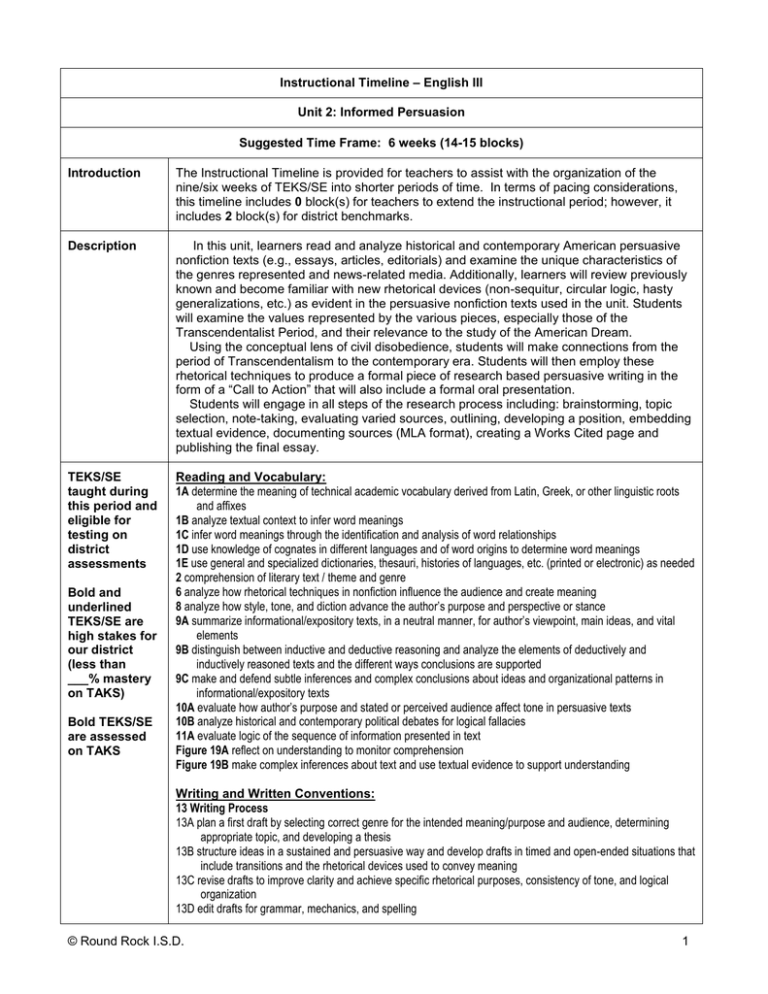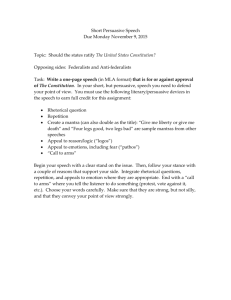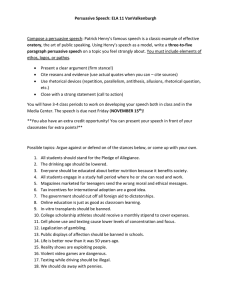Recommended Instruction Timeline
advertisement

Instructional Timeline – English III Unit 2: Informed Persuasion Suggested Time Frame: 6 weeks (14-15 blocks) Introduction The Instructional Timeline is provided for teachers to assist with the organization of the nine/six weeks of TEKS/SE into shorter periods of time. In terms of pacing considerations, this timeline includes 0 block(s) for teachers to extend the instructional period; however, it includes 2 block(s) for district benchmarks. Description In this unit, learners read and analyze historical and contemporary American persuasive nonfiction texts (e.g., essays, articles, editorials) and examine the unique characteristics of the genres represented and news-related media. Additionally, learners will review previously known and become familiar with new rhetorical devices (non-sequitur, circular logic, hasty generalizations, etc.) as evident in the persuasive nonfiction texts used in the unit. Students will examine the values represented by the various pieces, especially those of the Transcendentalist Period, and their relevance to the study of the American Dream. Using the conceptual lens of civil disobedience, students will make connections from the period of Transcendentalism to the contemporary era. Students will then employ these rhetorical techniques to produce a formal piece of research based persuasive writing in the form of a “Call to Action” that will also include a formal oral presentation. Students will engage in all steps of the research process including: brainstorming, topic selection, note-taking, evaluating varied sources, outlining, developing a position, embedding textual evidence, documenting sources (MLA format), creating a Works Cited page and publishing the final essay. TEKS/SE taught during this period and eligible for testing on district assessments Reading and Vocabulary: 1A determine the meaning of technical academic vocabulary derived from Latin, Greek, or other linguistic roots and affixes 1B analyze textual context to infer word meanings 1C infer word meanings through the identification and analysis of word relationships 1D use knowledge of cognates in different languages and of word origins to determine word meanings 1E use general and specialized dictionaries, thesauri, histories of languages, etc. (printed or electronic) as needed 2 comprehension of literary text / theme and genre 6 analyze how rhetorical techniques in nonfiction influence the audience and create meaning 8 analyze how style, tone, and diction advance the author’s purpose and perspective or stance 9A summarize informational/expository texts, in a neutral manner, for author’s viewpoint, main ideas, and vital elements 9B distinguish between inductive and deductive reasoning and analyze the elements of deductively and inductively reasoned texts and the different ways conclusions are supported 9C make and defend subtle inferences and complex conclusions about ideas and organizational patterns in informational/expository texts 10A evaluate how author’s purpose and stated or perceived audience affect tone in persuasive texts 10B analyze historical and contemporary political debates for logical fallacies 11A evaluate logic of the sequence of information presented in text Figure 19A reflect on understanding to monitor comprehension Figure 19B make complex inferences about text and use textual evidence to support understanding Bold and underlined TEKS/SE are high stakes for our district (less than ___% mastery on TAKS) Bold TEKS/SE are assessed on TAKS Writing and Written Conventions: 13 Writing Process 13A plan a first draft by selecting correct genre for the intended meaning/purpose and audience, determining appropriate topic, and developing a thesis 13B structure ideas in a sustained and persuasive way and develop drafts in timed and open-ended situations that include transitions and the rhetorical devices used to convey meaning 13C revise drafts to improve clarity and achieve specific rhetorical purposes, consistency of tone, and logical organization 13D edit drafts for grammar, mechanics, and spelling © Round Rock I.S.D. 1 Instructional Timeline – English III Unit 2: Informed Persuasion 13E revise final draft based on feedback from peers and teacher and publish written work for appropriate audiences 15Cv anticipates and responds to readers’ questions or contradictory information 16A clear thesis with support 16 write an argumentative essay to the appropriate audience that includes 16A a clear thesis or position based on logical reasons supported by precise and relevant evidence 16B accurate, honest representation of divergent views 16C appropriate organizational structure 16D information on the complete range of relevant perspectives 16E demonstrates consideration of the validity and reliability of sources used 16F uses language crafted to move a disinterested or opposed audience and specific rhetorical appeals to back up assertions 17A uses and understands the function of different types of clauses and phrases 17B uses a variety of correctly structured sentences 18 correctly and consistently uses conventions of punctuation and capitalization 19 spells correctly, including using various resources to determine and check correct spellings Listening/Speaking and Oral Conventions: 24A listen responsively and ask appropriate questions that reflect an understanding of the content and identifies the positions taken and the evidence of support of said positions 24B evaluate the clarity and coherence of a speaker’s message and critique the impact of the speaker’s diction and syntax on audience 25 give a formal presentation that exhibits logical structure, smooth transitions, accurate evidence, well-chosen details, and rhetorical devices, and employs eye contact, speaking rate, volume, enunciation, gestures, and conventions of language to communicate ideas effectively 26 participate productively in teams, offering purposeful ideas or judgments, asking relevant and insightful questions, tolerating a range of positions and ambiguity in decision-making, and appropriately evaluating the work of the group Research: 20A brainstorm, consult with others, decide on a topic, and formulate a major research question to address the topic 20B formulate a plan for engaging in in-depth research on a complex, multi-faceted topic 21A follow the research plan to gather evidence from experts and appropriate texts on the topic, distinguishing between reliable and unreliable sources and avoiding over-reliance on one source 21B systematically organize relevant and accurate information to support ideas, concepts, and themes, outline ideas into conceptual maps/timelines, and separate factual data from complex inferences 21C paraphrase, summarize, quote, and accurately cite all researched information according to a standard format, differentiating among primary, secondary, and other sources 22A modify the major research question as needed to refocus the research plan 22B differentiate between theories and the evidence that supports them and determine the strength of evidence found and how that evidence helps create argument 22C critique research process at each step and revise as needed 23 synthesize research into a written or oral presentation that 23A provides an analysis that supports personal opinions, rather than simply restating existing information 23B uses variety of formats and rhetorical strategies to argue for thesis 23C develops argument that incorporates the complexities of and discrepancies in information from multiple sources and anticipates and refutes counter-arguments 23D uses a style manual (e.g., MLA) to document sources and format written materials 23E is of sufficient length and complexity to address the topic Generalizations An effective piece of writing possesses a combination of defining traits including: fully developed ideas, strong and logical organization, precise and appropriate word choice, engaging narrative voice, varied and fluent sentence structure, and accurate conventions. © Round Rock I.S.D. 2 Instructional Timeline – English III Unit 2: Informed Persuasion To persuade effectively, writers must analyze their audience and make rhetorical choices appropriate for that audience. Essential Questions FIRST SEMESTER GUIDING QUESTION: What are the origins of the American Dream, and how does an individual discern his own American Dream in a complex and dynamic society? Essential Questions: For students’ understanding and study of literary periods: o How are authors of the Transcendentalist Period influenced by their social, political, and cultural surroundings? o What messages and themes are the Transcendentalist texts conveying? o How can reading works of literature from the Transcendentalist Period contribute to our understanding of our diverse nation? o What thematic commonalities can be drawn between these periods and contemporary works? o How do these messages and themes connect to the lens of the American Dream? What reading strategies help us effectively derive meaning from works of persuasive nonfiction such as editorials, letters, speeches, essays? What characterizes effective persuasive texts? What are rhetorical devices and appeals, and how are they used to make speeches effective, convincing, and memorable? How do rhetorical appeals aid in the development of a persuasive text? How do writers effectively utilize rhetorical devices in persuasive writing? How do nonfiction writers use logic and evidence to achieve their purposes? How can anecdotes, descriptions, and specific examples enhance persuasive writing? What strategies might a writer use to maintain coherence in a persuasive essay? How do writers determine the most effective organizational structure for a specific persuasive essay? What is the purpose of expository writing? What characterizes effective expository texts? How do the purpose and techniques used in expository writing differ from those of persuasive and narrative writing? How are persuasive strategies incorporated into expository writing? Why is it important to consider the audience when writing? How do writers take into account the audience when developing writing? What determines the most effective organizational structure for a specific essay? How do effective writers achieve closure? How can students determine what information is reliable on the internet? © Round Rock I.S.D. 3 Instructional Timeline – English III Unit 2: Informed Persuasion Core Components Teaching Notes: This unit is designed to teach the various elements of persuasive communication through reading and analyzing persuasive nonfiction pieces including letters, essays, speeches, and memoirs. Selections from the book serve as examples for students to model as they plan their own persuasive communication. Students should be able to communicate and respond to an author’s claims, compare claims from opposing sources, develop a position of their own, and communicate that position in an effectively crafted persuasive speech to be delivered to the class. Teachers should review the resources in Graff and Birkenstein’s They Say/I Say, The Moves that Matter in Academic Writing and David Joliffe’s Rhetorical Framework to help guide students through analyzing and responding to sources. Pacing Considerations: Blocks 1-2: Introduce the terminology of persuasion and nonfiction through study of transcendentalists. (consider using Joliffe’s Rhetorical Framework). Blocks 3-5: Introduce Current Issue Project, brainstorm and narrow topics to a manageable research question; use selections from the textbook to practice communicating the claims in a persuasive piece (consider Graff and Birkenstein’s “Quotation Sandwiches”). Blocks 6-8: Guide students through research and finding sources (library and internet). Utilize online databases. Use selections from textbook to practice responding to sources (consider Graff and Birkenstein’s “Three Ways to Respond”). Students then write responses to the claims in the sources for their research topic. Blocks 9-11: Review organizational strategies for persuasion using professional models (161) and writing workshop (160). Guide students through outlining, drafting, and editing their speeches. Blocks 12-13: Students deliver speeches to classmates and evaluate each other’s speeches. Student vocabulary: 6+1 Traits vocabulary (see 11.1a), Analysis / Analyze, Circular logic, Civil disobedience, Deductive reasoning, Evidence, Citations / Direct quotations (Paraphrase, Synopsis), Exposition / Expository writing, Genre, Audience, & Purpose, Hanging indent, Hasty generalizations, Inductive reasoning, Inference, Literary periods or movements, MLA format Non-sequitur, Objectivity v. subjectivity, Parenthetical documentation, Persuasion / Persuasive writing, Plagiarism, Rebuttal, Rhetoric, Rhetorical Appeals, (Logos, Ethos, Pathos), Rhetorical Device, Source credibility, Summary, Theme (thematic concept, theme statement), Thesis, Transcendentalism, URL, Works Cited, Writing process vocabulary (see 11.1a) Curricular Connections (within, between, and among disciplines) All of the TEKS that are reviewed in this unit have already been taught in elementary school. ELAR/TEKS Vertical Alignment K-12 Social Studies: period specific or historical information of necessity to students’ understanding of the piece(s) vital to the unit concepts —in this case, the Transcendentalist movement Social Studies: contemporary examples of civil disobedience Communication Applications: Formal oral presentation skills Science and technology: Students may choose current issues topics related to the field of science and technology. Business: Students may choose current issues topics related to the field of business. © Round Rock I.S.D. 4 Instructional Timeline – English III Unit 2: Informed Persuasion Required Lessons Concepts/skills: Rhetorical triangle: occasion, speaker, audience Rhetorical appeals: logos, ethos, pathos Rhetorical strategies: diction, imagery, organization, figurative language, point of view Logical fallacies (non-sequitur, circular logic, hasty generalizations) Research process Documentation guidelines (MLA) Products: Research based Current Issue “Call to Action” persuasive speech Recommended Lessons and Learning Experiences Differentiation: See textbook for ideas for struggling readers. English Language Proficiency Standards Student Expectations with Sentence Stems and Activities to support implementation of the Standards (Note: when you open the link, it may ask you for a certificate or if it is OK to open the file, click OK each time you see the screens.) Instructional Resources Suggested TEXTBOOK Selections: Transcendentalism selections Henry David Thoreau’s from Walden (220); from Civil Disobedience (228); from The Journal (189) Ralph Waldo Emerson’s from Nature (196); from Self-reliance (200) Speeches and Persuasive Non-fiction selections Jonathan Edwards’s from Sinner’s in the Hands of an Angry God (97) Patrick Henry’s Speech to the Second Virginia Convention (122) Mohandas K. Gandhi’s On the Eve of Historic Dandi March (235) Frederick Douglass’s from The Meaning of July Fourth for the Negro (343) Abraham Lincoln’s from Second Inaugural Address, March 4, 1865 (345); The Gettysburg Address (410) Sojourner Truth’s And Ain’t I a Woman? (376) Chief Joseph’s I Will Fight No More Forever (553) E.E. Cummings’s from I: Six Nonlectures (673) John F. Kennedy’s Remarks at Amherst College (755) Franklin D. Roosevelt’s The Four Freedoms (883) William Faulkner’s Address upon Receiving the Nobel Prize for Literature (904) Martin Luther King, Jr.’s from Letter from a Birmingham Jail (1165) For writer’s workshops, teaching concepts, and extension activities: Becky Cain’s from Proposals for Electoral College Reform (161) Time How they Chose These Words (134) Steve Rushin’s “Give the Kids a Break” http://sportsillustrated.cnn.com/vault/article/magazine/MAG1114294/index.htm Rick Reilly’s “Nothin’ But Nets” http://sportsillustrated.cnn.com/2006/writers/rick_reilly/04/25/reilly0501/index.html © Round Rock I.S.D. 5 Instructional Timeline – English III Unit 2: Informed Persuasion INTERNET: American Art Interactive Timeline: http://www.phillipscollection.org/research/american_art/timeline.htm Transcendentalism: http://web.csustan.edu/english/reuben/pal/chap4/4intro.html Video links to speeches: http://www.americanrhetoric.com Research resource: www.roundrockisd.org/index.aspx?page=2456 (passwords available in library) Argumentation resources: http://www.americanrhetoric.com Citing sources: http://owl.english.purdue.edu/owl/resource/557/01/ Tool for citing sources: http://www.noodletools.com/quickcite/ TAKS open-ended question stems (example questions available at www.tea.state.tx.us Synthesis Essay examples from AP Language and Composition Exam http://apcentral.collegeboard.com/apc/public/courses/teachers_corner/2123.html Rhetorical Framework David Joliffe http://www.docstoc.com/docs/4202134/Rhetorical-Framework-Diagram Additional Teacher Resources: MLA Handbook Crafting Expository Argument, Michael Degen They Say, I Say: The Moves That Matter In Academic Writing, Gerald Graff and Cathy Birkenstein Everyday Use: Rhetoric at Work in Reading and Writing, Hepzibah Roskelly and David Joliffe Assessment Resources Common Authentic Assessments: Write an interpretive response to an expository text that anticipates and responds to readers’ questions or contradictory information, including the use of properly documented embedded quotations. (This can be drafted in the Reader Response journal, as a Short Answer Response, or through similar informal means.) Compose, revise, and edit research-based persuasive writing (e.g. “call to action” essay, letter, editorial, etc.) that takes a distinctive position and appeals to a specific audience. The persuasive essay should include a clear thesis, supporting evidence, fair representation of rebuttal and relevant perspectives, use rhetorical strategies, appropriate organization, while practicing the skills of paraphrase, summary, and direct quotation while accurately citing all researched information in MLA style documentation. Give a formal presentation with a logical structure, smooth transitions, accurate evidence, well chosen details and rhetorical devices while employing appropriate presentation skills (e.g., eye contact, speaking rate, etc.) Suggested Tasks: Reader Response journals—Suggestions: write a brief opposing argument in response to a self-selected editorial (include the selected editorial on the preceding journal page); excerpt a passage from a piece of Transcendentalist literature and respond with your interpretation of its meaning and opinion of its validity; collect information about an issue or cause in which you are interested (esp. one that might be the basis of your “call to action” assignment), including names and contact info for any local or state organizations you could consult in order to get involved. Writer’s Notebook entries—Suggestions: take a ‘field trip’ and write outside; change a studied passage from one genre to another; revise a section of original student work from a previous entry. Short Answer Responses (focused on the expository) © Round Rock I.S.D. 6 Instructional Timeline – English III Unit 2: Informed Persuasion Annotations Extension TEKS © Round Rock I.S.D. 7





